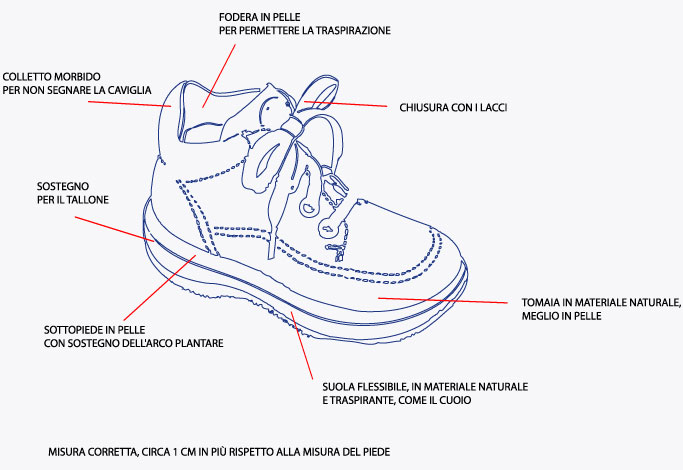Choosing the right shoe

What do you look for when you buy shoes for children? What factors do you focus on?
A distinction should be made between buying a shoe for first steps and one for older children.
For infants
This generally means shoes that are suitable for children between one and three years old and includes sizes from 19 to 27.
The prerequisites are:
- the use of natural materials and therefore, real leather for the upper, lining and insole, leather with a non-slip tread or lightweight rubber for the sole.
- a high degree of flexibility at the front of the shoe to allow the child to run and stand on tiptoe. An effective method of checking the flexibility of the sole is to bend the shoe tip backwards by ninety degrees by just pressing with your hand, while inserting the thumb of your other hand inside the shoe to avoid damaging it.
- a wide tip to allow freedom of movement and the correct articulation of the toes.
- the correct size, leaving a good centimetre free between the big toe and the shoe tip, as the foot grows quickly in the first few years.
- not too low in the back part, slightly high is, in fact, better, but not above the ankle to avoid limiting movement and with reinforcement on the heel pad to provide support. A soft collar also helps improve comfort where the ankle touches the shoe when walking.
Three years and over
After this phase, the choice can be less strict and include various factors such as sturdiness or fashion trends. The general criteria still apply for any type of footwear.
Comfort
Make sure the shoes you wish to buy are comfortable. This means flexibility, accompanying the movement of the child’s foot, good quality material and the shape of the shoe which adapts well to the foot.
Lightness
It is important that the shoes are lightweight to avoid increasing the effort made by the child when playing and running.
Sturdiness
To allow children to move freely and protect them from possible knocks, but also because at this age, they frequently wreck their shoes.
Suitable for the season
Our feet are sensitive to heat and cold. For the winter, closed, warm shoes, including woollen lining in the coldest months, while in the summer, lighter models which let the foot breathe, including open-toe models. Avoid switching directly from winter shoes to summer ones, and vice versa. Mid-season shoes are important because they allow the foot to gradually adjust to the new temperatures.
Types of footwear
The world of children's footwear offers a range of models and types which is just as comprehensive as that of adults, and regardless of the choices related to personal taste and colour, there are some reference categories that can help in the choice.
Open-toe shoes
These are so-called sandals, shoes that are completely open, with buckles or Velcro tabs for closure, indicated for the summer period. They leave the foot free, allowing it to breathe properly while providing adequate protection. We believe that if they are not at least partially closed on the tip, they are not suitable for infants. Indeed, flip flops should never be worn by infants as they can cause damage, even trauma in some cases, since they are only held on the foot at the front. It is better to use sandals that close at the back for the beach. You should only consider buying flip flops when the children are older and walk more confidently.
Open-sided shoes
A classic children’s shoe, the “two-hole” model falls into this category. Its success is due to the fact that is a good compromise between open-toe shoes, which are not very protective, and closed shoes, which are not very comfortable in hot weather. They are generally open on the sides and have holes (usually two) in the upper part, and are fastened with a buckle or Velcro. As already mentioned, they guarantee proper protection and adequate breathing.
Closed shoes
This category covers numerous models for all seasons. They range from on-trend sports sneakers in leather or canvas, which boys in particular tend to wear all year round, to typical winter shoes which keep the foot warm and guarantee protection against knocks, hazards and unsuitable material. They are fastened with laces, Velcro or zips.
Here are the main types:
- Leather or canvas sneakers
They feature in most people’s wardrobes and are the most practical solution when choosing children’s shoes because they are comfortable, protective and sturdy. Nowadays, there are many brands of this type of shoe, but it is important to keep in mind that they are not all the same in terms of quality of material or construction techniques (even in the Far East there are different levels of production quality), so it is better to rely on more well-known brands.
In our opinion, they are not the best choice up until three years of age or they should not be the only choice. It is not a good idea to wear them all day.
- Ankle boots
Ankle boots are boots that more or less reach the height of the ankle bone and are commonly used for infants which we will talk about in more detail in the dedicated section. They are frequently worn by boys in the winter in bigger sizes.
- Boots
They have become very common in girls’ wardrobes over the last few years. They meet both the criteria for the winter and girls’ natural desire "to be fashionable". They come in various heights (the lowest are called ankle boots), but it is important to check the size of the calf when choosing them, because if the leg is too thin, the result will not be very attractive while a leg that is too sturdy is likely to make it difficult to close the zip.
Orthopaedic shoes
These are a special category of shoes. They are not worn by everybody, but only by those who have a minor or major defect that needs correcting. It is important to wear them only when recommended by a doctor after a thorough examination and assessment. Orthopaedic shoes for children should never be chosen without proper medical consultation. For this reason, they are not included in our range.
The foot’s development
At birth, the child’s foot is not fully formed. The most important difference is the absence of the arches in the foot. A child’s foot is physiologically flat due to the large amount of lipids in the sole of the foot.
It has, however, the same number of sweat glands and nerve endings that it will have when the child grows up.
These characteristics suggest that it is better to avoid using shoes during the first few months of life, leaving infants barefoot or protected by socks or booties to keep their feet warm. In this way, infants can explore the world around them with their feet, which they often put in their mouths, and the feet can also breathe naturally.
When children start to take their first steps, ideally they should walk barefoot on surfaces, such as sand, grass, or even earth and stones, because these stimulate the action of the foot and the development of its muscles, helping the arches of the foot to form, thus eliminating flat feet.
Since, in the vast majority of cases, this is not possible or, at least, not every day, you should bear in mind that since the floor in your home is perfectly flat, it does not offer the stimulus of natural ground, therefore, either non-slip socks are recommended, especially in the winter months, which provide a little more padding than traditional socks, or very light and comfortable fabric slippers that, with minor support of the heel pad, allow greater safety in movement.
For the first family walks, in places other than those mentioned or otherwise in unprotected places, it is essential to purchase an appropriate pair of shoes with the characteristics that are detailed separately.
We would also like to point out that it is better to avoid “hand-me-down” shoes, given that the shoe takes on the shape of the foot and every foot is different.
A “used” shoe, even if it looks in good condition, already has the shape of the person who wore it before and you run the risk that the “new” foot will take on a posture that it is not its own and will compromise its normal development.

